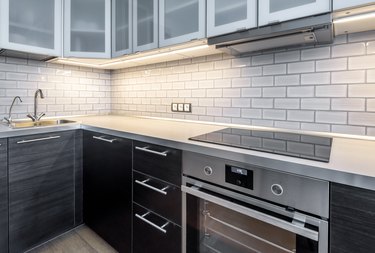
If you're thinking of replacing your gas range and oven with an electric one, or you want to install an electric range in a part of your kitchen that didn't have one before, you are going to have to install a dedicated circuit for it, as required by code. This is normally a job for a licensed electrician, but if you're on your own, it's important to understand oven and range electrical requirements before you start.
Even though many localities allow homeowners to do electrical work themselves, they require a permit and an electrical inspection. Even if they don't, it's prudent to get your work inspected anyway.
Video of the Day
Video of the Day
Electric Stove Power Requirements
The power an electric appliance consumes is the product of the supplied voltage and the current. An electric range needs much more power than most other appliances, so if it operated at the same voltage, it would draw an enormous amount of current. To get around this, large appliances like stoves and water heaters operate at double the voltage of smaller appliances, or 240 volts rather than the 120 volts supplied to a standard power receptacle. The voltage for an electric stove may be listed as 220, 240 or 250 volts, but these all mean basically the same thing.
Power is supplied from the line to the panel at 240 volts, and it's split into two 120-volt legs. Standard 120-volt circuits tap into one or the other of these legs, but a 240-volt circuit taps into both of them. Therefore, a 240-volt cable includes an extra hot wire, which is red, along with the black hot wire, the white neutral wire and the green or bare ground. The receptacle for a 240-volt circuit must accommodate all four wires, so it's bigger than a standard 120-volt one, and its shape and pin configuration depend on the current draw of the appliance using it.
Because a stove draws so much current, the wires must be fatter than those for other appliances, and the wire gauge, which is a measure of thickness, must be lower to prevent overheating. Remember, the lower the American Wire Gauge (AWG) number, the thicker the wire. The top gauge for a 120-volt circuit is normally 12 AWG, but the minimum gauge is 8 AWG for a 30-amp stove and 6 AWG for a 50-amp one, according to ApplianceAid.com.
What You Need to Buy
The voltage for an electric stove is 240 volts but the current draw varies, and you can find it displayed on a label affixed to the back of the oven near the electric connection. Once you know that, you can purchase the receptacle, cable and circuit breaker. It's usually easy to determine which receptacle you need, because its pin configuration has to match that of the range plug. For reference, here are the requirements for 30- and 50-amp stoves and ovens:
- 30 amp: NEMA 14-30 receptacle, 8 AWG 3-conductor cable and a 30-amp, double-gang circuit breaker. The ground wire isn't counted as a conductor, so a 3-conductor cable has four wires.
- 50 amp: NEMA 15-50 receptacle, 6 AWG 3-conductor cable and a 50-amp, double-gang circuit breaker.
Replacing an Old Electric Stove
The National Electric Code grounding requirements have changed over the years. If you have an old house and a stove that you've been using for a long time, the circuit supplying it may not have a ground wire. Technically, code changes don't affect pre-existing wiring, so you could leave the wiring as it is and adapt the stove connection to fit. There's a good reason why you don't want to do that.
Modern ranges come with features that use 120-volt power, such as the timer, light and electronic programming. These features use one leg of the 240-volt circuit, and in old 3-wire circuits, the neutral wire supplies the ground path. Many features on new stoves, however, particularly the electronic ones, are sensitive and need an independent ground path to function properly, so if you keep the old wiring, the stove probably won't work to way it's supposed to.